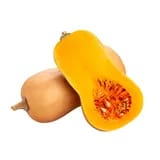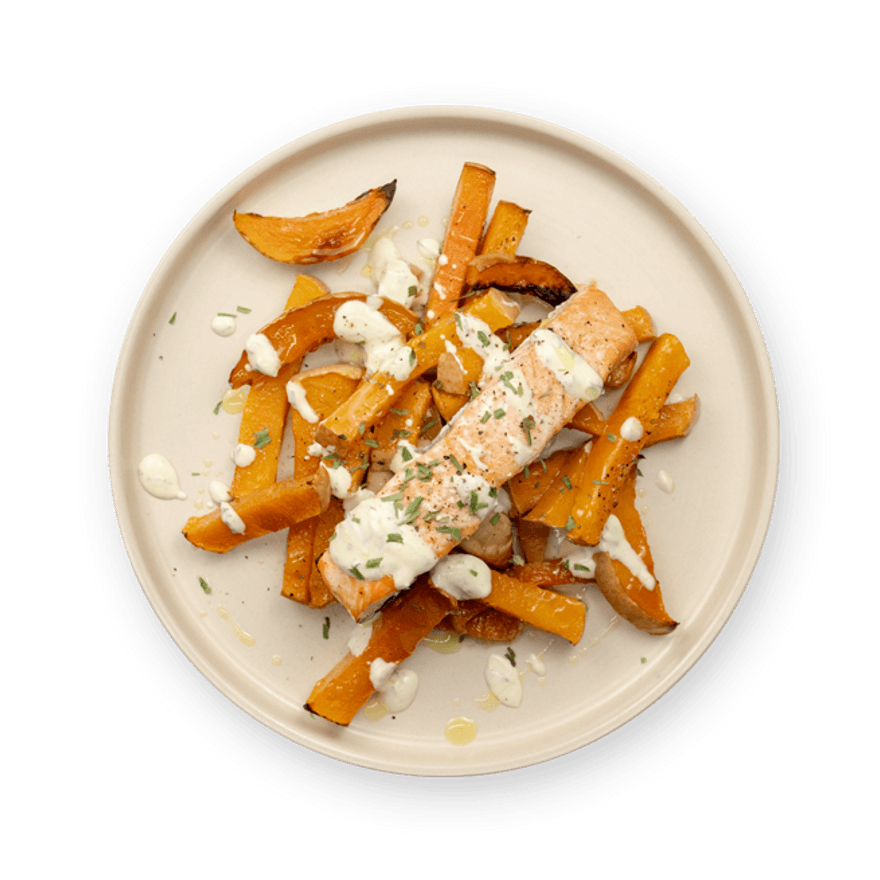Roasted Salmon & Butternut Squash
689 reviewsThe perfect balance of sweet & savory, this gourmet meal is ready in a flash !

Ingredients
Make sure you have...
Utensils
Oven, Parchment paper
recipe

Step 1
If needed, thaw your salmon. Preheat the oven to 220°C. Wash & halves the squash. Empty out the seeds & slice the squash into thin rounds. Slice the rounds into 1cm thick sticks.

Step 2
Ona parchment paper lined sheet tray, add the squash. Drizzle over with maple syrup & olive oil. Season with salt & pepper & roast in the oven for 20 min at 220°C.



Step 3
Meanwhile, prepare the yogurt sauce. In a small bowl, combine : the greek yogurt, mustard & tarragon. Season with salt & pepper

Step 4
After 20 min, remove the sheet tray from the oven & add the salmon filets on top. Lightly drizzle them with maple syrup & bake for another 10 min at 220°C.
Step 5
Once the veg is tender & the salmon is cooked through, remove the sheet tray from the oven & serve the roasted salmon & squash in a plat. drizzle over with the yogurt sauce & re-season to taste. Enjoy !
Personal notes
Add your own flavor!
Nutrition facts
Average estimated amount for one serving
| Energy | 392 cal. |
| Fat | 22 g |
| Carbohydrates | 27 g |
| Protein | 30 g |
| Fiber | 6 g |
Values are based on an average estimate for one serving. All nutrition information presented on Jow is intended for informational purposes only. If you have any concerns or questions about your health, please consult with a health-care professional.
On average, one serving of the recipe "Roasted Salmon & Butternut Squash" contains 392 Energy, 22 g of Fat, 27 g of Carbohydrates, 30 g of Protein, 6 g of Fiber.
Price per portion
| € | Nos recettes à -2 € par portion |
| €€ | Nos recettes entre 2 € et 4 € par portion |
| €€€ | Nos recettes à +4 € par portion |
Please note, the price above is dependent on your grocer and the available products in the grocery store you chose.
Scores


A Nutri-score
The Nutri-score is an indicator intended for understanding nutritional information. Recipes or products are classified from A to E according to their food composition to promote (fiber, proteins, fruits, vegetables, legumes, etc.) and foods to limit (energy, saturated fatty acids, sugars, salt, etc.).
A Green-score
The Green-score is an indicator representing the environmental impact of food products. The recipes or products are classified from A+ to F. It takes into account several factors on the pollution of air, water, oceans, soil, as well as the impacts on the biosphere. These impacts are studied throughout the product life cycle.
Retrieving reviews...


